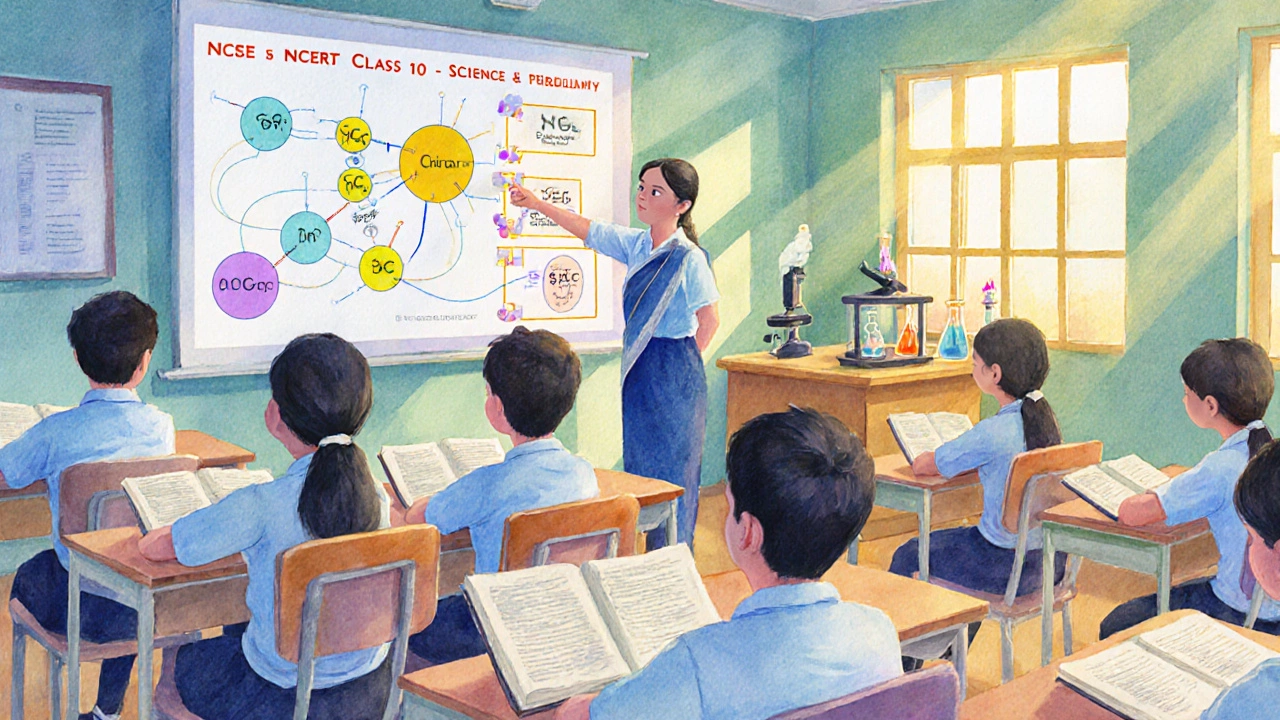CBSE vs State Boards vs ICSE Comparison Tool
Compare Education Boards
Select the boards you want to compare to see key differences in curriculum, exams, and recognition
Comparison Results
| Aspect | CBSE | State Boards | ICSE |
|---|---|---|---|
| Administering Body | Central Board of Secondary Education (Government) | State Education Departments | Council for the Indian School Certificate (Private) |
| Curriculum Focus | Uniform national syllabus, emphasis on Science & Math | Varies by state, includes regional language emphasis | Comprehensive, with strong English language component |
| Exam Structure | Objective + Subjective, 10+2 system | Mostly subjective, state-specific pattern | Both objective and subjective, rigorous evaluation |
| Recognition for Competitive Exams | Direct alignment with NEET, JEE, AIIMS | Requires additional preparation for national exams | Accepted, but students often need extra coaching |
| Number of Affiliated Schools | 21,000+ | 30,000+ | 2,000+ |
When you hear CBSE is the Central Board of Secondary Education, the national board that governs school education in India, you probably wonder what the abbreviation really means and why it matters to millions of students, parents, and teachers.
Decoding the Acronym
CBSE literally stands for Central Board of Secondary Education. Established in 1962, the board operates under the Ministry of Education, Government of India. Its mandate is to design curricula, conduct examinations, and maintain academic standards for affiliated schools across the country and abroad.
Historical Snapshot and Governance
The board was created to bring uniformity to secondary education after India’s independence. Its headquarters sit in New Delhi, and a council of educationists, administrators, and government officials guides policy. Over the decades, CBSE has introduced continuous reforms-like the shift to a 10+2 system in the 1970s and the recent emphasis on competency‑based learning.
CBSE Within the Indian Education Landscape
India’s education system is a patchwork of central, state, and private boards. Indian education system encompasses multiple curricula, exam boards, and regulatory bodies that together serve over 260 million students. CBSE is the largest central board, with more than 21,000 schools under its umbrella, far outnumbering state boards and the International Certificate of Secondary Education (ICSE).
Understanding the CBSE Syllabus
The CBSE syllabus is crafted by the board in collaboration with the NCERT National Council of Educational Research and Training, the authority that writes the core textbooks used by CBSE schools. It is divided into two stages:
- Class 10 (Secondary): Focuses on foundational concepts across Science, Mathematics, Social Studies, Languages, and Arts. Assessment is split between internal assessments and the All India Secondary School Examination (AISSE).
- Class 12 (Senior Secondary): Offers three streams-Science, Commerce, and Humanities. The board conducts the All India Senior School Certificate Examination (AISSCE) which determines college eligibility.
Each subject is mapped to specific learning outcomes, with a gradual shift toward application‑based questions and project work.

Exam Pattern, Grading & Competitive Exams
CBSE’s assessment model blends objective (multiple‑choice) and subjective (written) questions. For Class 10, the AISSE consists of 80 marks for internal assessment and 120 marks for the written exam. For Class 12, the AISSCE carries 400 marks, split equally between theory and internal/practical components.
Why does this matter for aspirants of NEET National Eligibility cum Entrance Test, the gateway exam for medical colleges in India and JEE Joint Entrance Examination, the primary test for engineering institutes like IITs? Both exams align closely with the CBSE Science syllabus, meaning a student who masters the CBSE curriculum is already on track for these national-level tests.
Comparing CBSE, State Boards & ICSE
| Aspect | CBSE | State Board | ICSE |
|---|---|---|---|
| Administering Body | Central Board of Secondary Education (Government) | State Education Departments | Council for the Indian School Certificate (Private) |
| Curriculum Focus | Uniform national syllabus, emphasis on Science & Math | Varies by state, includes regional language emphasis | Comprehensive, with strong English language component |
| Exam Structure | Objective + Subjective, 10+2 system | Mostly subjective, state‑specific pattern | Both objective and subjective, rigorous evaluation |
| Recognition for Competitive Exams | Direct alignment with NEET, JEE, AIIMS | Requires additional preparation for national exams | Accepted, but students often need extra coaching |
| Number of Affiliated Schools (approx.) | 21,000+ | 30,000+ | 2,000+ |
If you’re deciding which board suits your child, consider factors like future career plans, language preference, and the availability of quality schools in your region.
How Schools Gain CBSE Affiliation
Affiliation isn’t automatic. A school must submit an application to the CBSE affiliation committee the body that reviews infrastructure, teacher qualifications, and compliance with board norms. Key criteria include:
- Minimum land area and built‑up space per student.
- Qualified teaching staff with at least a B.Ed. degree.
- Adherence to the prescribed curriculum and assessment methods.
- Regular audit reports submitted to the board.
Once approved, the school receives an affiliation number, gaining the right to appear in the CBSE list and to conduct AISSE and AISSCE exams.
Who Benefits from the CBSE Curriculum?
Students get a nationwide recognized certificate, easing college admissions across India. Teachers receive standardized training modules and access to CBSE’s digital resource portal. Parents appreciate transparent grading and the board’s focus on analytical skills.
Common Misconceptions About CBSE
Many think CBSE is “easier” than other boards. In reality, the difficulty level varies by subject and school quality. Another myth is that CBSE ignores arts and humanities - the syllabus actually mandates a balanced blend, with mandatory language and social science periods.
Practical Tips for CBSE Learners
- Start Early for Board Exams: Begin revision at least three months before AISSE/AISSCE.
- Use NCERT Textbooks: They are the definitive source for board questions.
- Practice Past Papers: Solving at least five years of previous exam papers improves time management.
- Focus on Internal Assessments: They contribute 20‑30% of your final mark.
- Blend Theory with Application: Conduct small experiments for Physics and Chemistry to cement concepts.
Sticking to these habits can boost confidence and scores, especially when aiming for competitive exams like NEET or JEE.
Key Takeaways
- CBSE stands for Central Board of Secondary Education, the largest national school board in India.
- The syllabus, crafted with NCERT, follows a uniform 10+2 structure and aligns closely with major entrance exams.
- Affiliation requires strict compliance with infrastructure, staff, and curriculum standards.
- When choosing a board, weigh career goals, language preferences, and school availability.
- Effective study habits-early revision, NCERT focus, past papers-are essential for success.
What does CBSE stand for?
CBSE is an acronym for Central Board of Secondary Education, the national board that governs school education in India.
Is the CBSE syllabus the same across all schools?
Yes. All CBSE‑affiliated schools follow the same NCERT‑based curriculum, though teaching methods may differ.
How does CBSE compare to state boards?
CBSE offers a uniform national syllabus, easier transfer between states, and direct alignment with exams like NEET and JEE, whereas state boards tailor content to regional languages and policies.
Can CBSE students appear for NEET and JEE?
Absolutely. The CBSE Science syllabus is designed to meet the prerequisites of both NEET and JEE, making preparation smoother for those exams.
What are the steps for a school to get CBSE affiliation?
The school must submit an application, meet infrastructure and staffing norms, adopt the CBSE curriculum, and pass an inspection by the affiliation committee.
